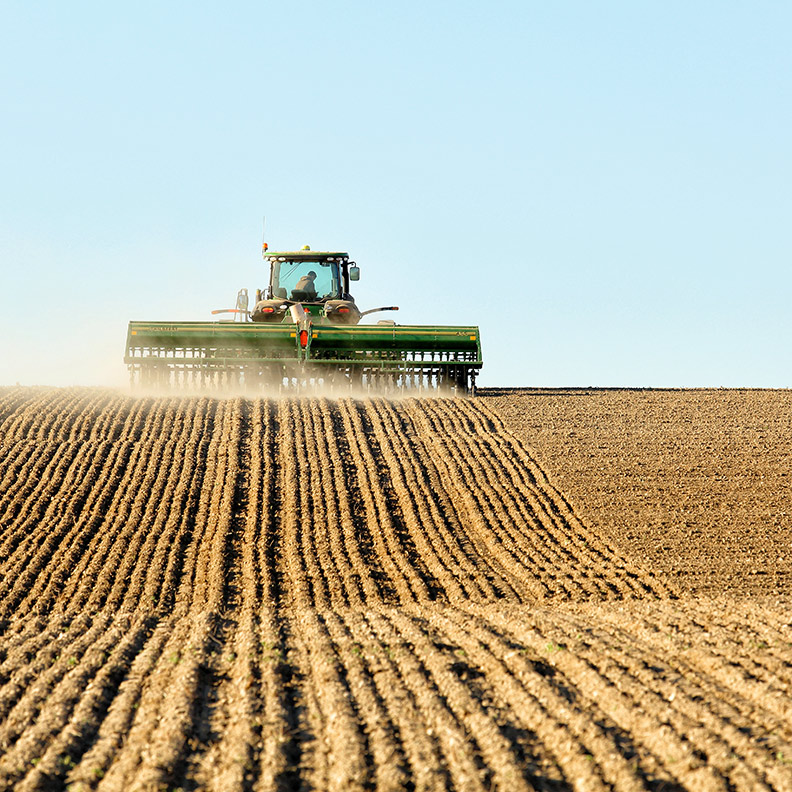It’s a season of change in the U.S. agriculture industry, as farmers gear up for spring planting amid an uncertain backdrop. With a new administration in Washington there has been a renewed focus on tariffs, which could raise the cost on imported goods that are critical to farmers, such as materials used in fertilizers1. Retaliatory tariffs by other countries may add complexity to ag export markets as well, at least in the short term.
There is also some uncertainty around tax credits for clean fuel production, or 45Z credits, that are available to farmers. Rules for the credits were not finalized before the new administration took office and a 90-day comment period, which started on Jan. 10, is still underway2. It remains to be seen what’s settled on at the end of that period and how the new administration decides to proceed with 45Z credits.
While these policy issues are playing out, farmers are also focusing on an evolving crop insurance marketplace and keeping a close eye on weather in key growing regions. Here’s a closer look at important industry trends worth monitoring to stay ahead in this fast-paced environment.
U.S. row crops
Current break-even prices without land costs are approximately $3.17 to $3.66 for corn and $6.53 to $8.38 for soybeans3. Land costs are variable, but they likely condense most if not all farmer margins as of now for the 2025 crop. The all-in corn cost is estimated at $4.05 per bushel4in the north valley region of North Dakota and $9.26 per bushel of soybeans. Farmers have likely made their major decisions for crop rotations, pending weather obstacles.
Fertilizer prices increased slightly throughout January5 but are lower than the five-year historical average. A unit of nitrogen is currently $0.45 for anhydrous on the low end and $0.58 for UAN28 on the high end.
The USDA decreased estimated 2024 U.S. soybean yields by nearly 2% to 50.7 bushels per acre, which fueled bullish sentiment. November 2025 soybeans are up over 4% to start the year. Meanwhile, March corn is up over 7% to start the year.
U.S. livestock and dairy
The average cash cattle prices have been very strong. The market experienced five straight weeks of all-time highs, culminating with a record price of $209.57 at the end of January. Wholesale prices are also very strong, in part due to the potential for lower imports from Mexico and Canada as a result of tariffs.
Mexico also accounts for nearly 40% of U.S. cheese exports, which means that new trade policy could greatly affect the cheese market and ultimately Class III milk prices. A recent delay in tariffs supported a rebound in the Class III price, which is currently at $19.92 on the March futures contract6.
Local ag outlook
Alex Marcotte, Ag Banker, Warren, MN
“A reason for famers to be excited right now is if the weather stays the way it has been. That could mean an earlier planting date and could help with higher yields.
“On the flip side, the markets are not looking great and land rents are high, which are both concerns shared by farmers I talk to.
“Land sales in the area have also been pretty steady. Farmers are always looking to increase the acreage in their operations.”
Global agriculture
The U.S. recently imposed — and then scaled back — tariffs on Canada, Mexico and China. It may take weeks or months to for markets to price in the true effect and longevity of these actions.
Brazil’s soybean crop is estimated to be 14% larger than last year’s record high7. Favorable weather contributed to a massive 22% positive adjustment in the largest producing state, Mato Grosso. If tensions rise between the U.S. and China as the result of tariffs, Chinese buyers will likely resort to buying more soybeans from Brazil, which will have a surplus.
Elsewhere in South America, the La Niña weather pattern has led to hot and dry conditions in Argentina, where corn yields are being slashed. The country is the No. 3 corn producer in the world. Argentinian President Javier Milei reduced taxes on ag commodities from 33% to 26% for soybeans and from 12% to 9.5% for corn, but farmers are reporting that they are not feeling the full effects yet8.
What to watch for
Tariffs continue to dominate headlines, and it remains to be seen what the full impact will be on the ag sector. Farmers are also eagerly keeping an eye on 45Z regulations. The credits could substantially increase the price of corn per bushel, but there is no guarantee that the program isn’t significantly changed or eliminated entirely by the new administration.
Closer to home, farmers are hoping for improved soil moisture across most of the Corn Belt prior to planting. With so many moving pieces in the industry, be sure to connect with an experienced ag banker for support with your operation.

